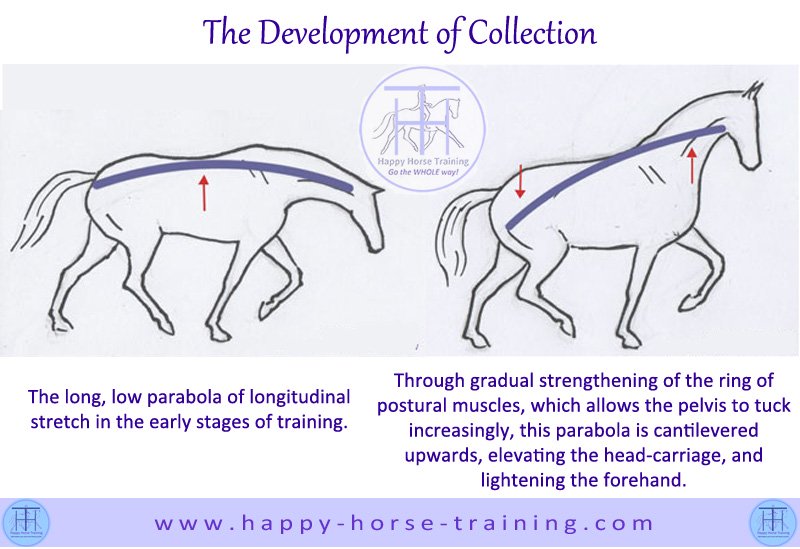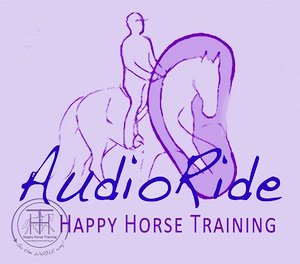The development of Collection

The development of collection is not something the rider imposes on the horse by altering the head carriage at a certain stage of training. It is the gradual result of strengthening of the postural ring, which transforms the horse's whole body on a profound level.
An extract from 'The Gymnastic Rider' :
'In all aspects of the contact in training the horse, we must be
diligent in seeing it only as the end result of the channeling of the
horse’s energy. This is never truer than in the evolution of the contact
– that is, the gradual development of the horse’s head-carriage, from
the low-parabola of early training to the raised head-carriage of
advanced work.
This transformation,
when it brought about correctly, is a whole body change. The difference
in the head carriage from early to advanced training is only a result
of the strengthening of the horse’s postural ring of engagement that
comes from the straightening and alignment process.
Unfortunately, because the head-carriage is the most obvious
manifestation of this change, many riders and trainers try to target it
directly, imposing a certain preconceived head-carriage on the horse at
each stage of training, instead of simply allowing the contact to be a
natural result of the postural engagement. As soon as the energetic
dynamic of ‘back-to-front’ is reversed in this way, because the rider is
trying to do something directly to the front-end of the horse that is
disconnected from what is happening behind, then the unification of the
horse’s body through engagement is lost, and the precious flow of
transmission that real dressage nurtures is extinguished.
The
transformation of the contact must be allowed to happen in its own time,
as a natural result of the strengthening of the postural ring through
straightening and work in engagement.
It is never the rider’s job to
attempt to influence the head carriage directly at any stage of
training, in any way, whether raising or lowering it.
A horse
‘comes up in front’ gradually, as a result of increased the tucking of
the haunches that postural strength allows. Equally the long, low
parabola of the young horse is a pure result of the longitudinal
stretch, which the rider cultivates with the seat, leg and posture. It
should never be necessary for it to be imposed with the rein or any
auxiliary aid.'
Go back to the Dressage Diagrams index page
Return from The Development of Collection to the Happy Horse Training homepage
The pages on HHT are so wide-ranging and interrelated that we strongly recommend you look at the site plan to find other subjects that may interest you.
New from HHT!
AudioRide is a series of exercises designed to listen to while you ride.
Audio descriptions guide you through each step of developing a balanced, dynamic connection with the horse through your position.
This truly innovative learning tool gives you a whole new way of being guided in your riding, in a calm, clear, step-by-step way.
Free Download! Introductory Exercise: Riding in the Now
The Gymnastic Rider eBook
Now available exclusively from HHT!
A unique, comprehensive guide to practical rider biomechanics. This professionally produced eBook takes the rider through the process of developing their body in the specific way that brings the horse's movement into harmony and balance, without force and constraint. Click here for full details, and to download the 15-page introduction to the book for free.
Join the Happy Horse Training group on Facebook!
See and share topical info, news and photo's, and take part in lively discussions.
Click here to go to the HHT group (make sure you log into fb first) and then click on the 'join' button at the top of the page.
Join the Whole Horse Newsletter!
HHT's free monthly newsletter giving you wide-ranging and intelligent insights into holistic horsemanship.
Just enter your details below to join.
Free bonus on the riding position with all new subscriptions: Ten Top Tips To Instantly Improve Your Connection With Your Horse.
Click here to see back issues of The Whole Horse newsletter
Train Your Horse
The Holistic Way
How To Train A Horse Without Force
is a unique guide to training horses through energetic connection and
gymnastic training. Part 1 covers everything on the ground, from
handling to the lungeing technique that develops strength, straightness
and engagement. Comes with a free eBook supplement on Horse Trauma.
Click here for more details.
"As a student of Zen Buddhism for nearly three decades, I've often wondered when someone was going to write the book on Zen and the art of horsemanship, and I think that your emphasis on mindfulness and energy connection gets right at the heart of the matter."
- Prof. Teresa Lloyd, U.S.
Do You Have
A Horse Story
To Share On HHT?
So many people have been through
wonderful experiences with horses, whether in training or otherwise. If
you've made a change in a horse's life - or one has made a change in
yours - tell us about it here.
Learn The Natural Barefoot Trim - The Simple Way
The Simple Seven-Step Natural Trim is a comprehensive step-by-step guide to a cutting-edge barefoot trim. Click here to find out more.
What people say about HHT:
"The riding instruction is outstanding, if instructors in the UK taught this way there would be a lot of happy riders and horses."
"The riding tuition exceeded my hopes and expectations by a long way; giving me an exciting new facet to horsemanship which is lighter. more subtle, more elegant and more meaningful. It is as if a new door has opened bringing more sunlight and air."
"My goodness - what a change has taken place in my riding. I think that I'm starting to sit 'into' the horse rather than on top of him. I felt my horse's movements in a way that has almost never happened before"
Click on Testimonials for more










New! Comments
Anything to say about this page? Leave your comment in the box below.